Meighan Theatre Building
Meighan Theatre (1926 – 1934)
New Port Richey Theatre (1937 – 1939)
Vogue Theatre (1939 – Abt. 1963)
The Cinema Theatre (Abt. 1963 – 1969)
Richey Suncoast Theatre (1972 – Present)
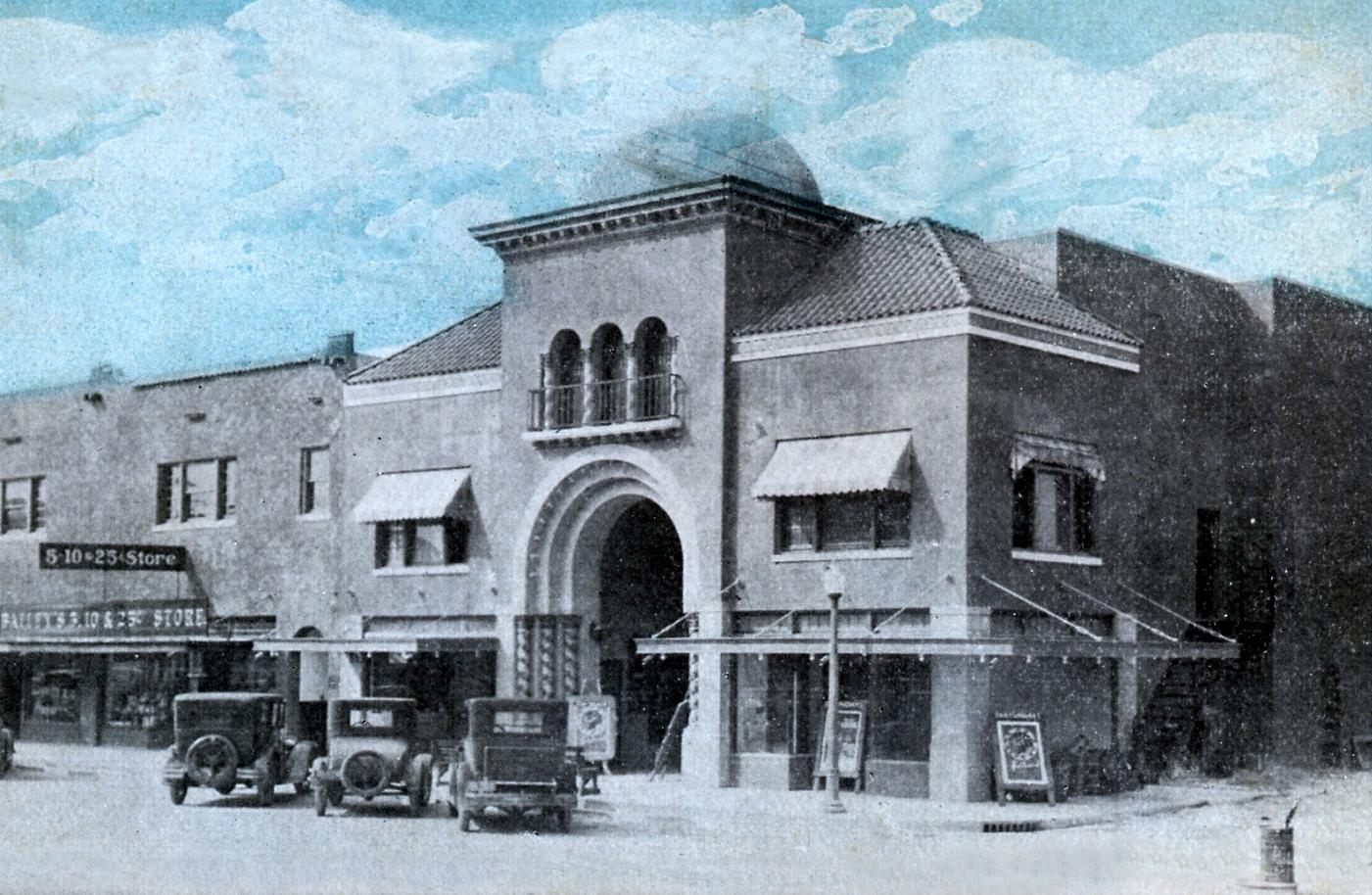
Southwest corner of Grand Boulevard & Nebraska Avenue, New Port Richey
The first theatre in New Port Richey was the Palms Theatre on Main Street. Owned by J. S. Jackson, it was a popular attraction for local residents. But with a dirt floor and bench seating, many prominent businessmen in the town thought a more prestigious theatre was needed to fulfill their idea of making New Port Richey the “Hollywood of the East”.
In September of 1925, an announcement was made by a group that had formed a business named the Richey Amusement Company that it was now in the process of raising capital to build a new theatre. The incorporators of the new company were W. K. Jahn, James. W. Clark, E. A. Leeston-Smith, Charles W. Barnett, F. I. Grey, and F. E. Dingus. Officers of the company were James Clark, president; E. A. Leeston-Smith and F. L. Grey, vice-presidents; W. K. Jahn, secretary; and Charles W. Barnett, assistant secretary and treasurer. They hoped to raise $50,000 to get the project off the ground.
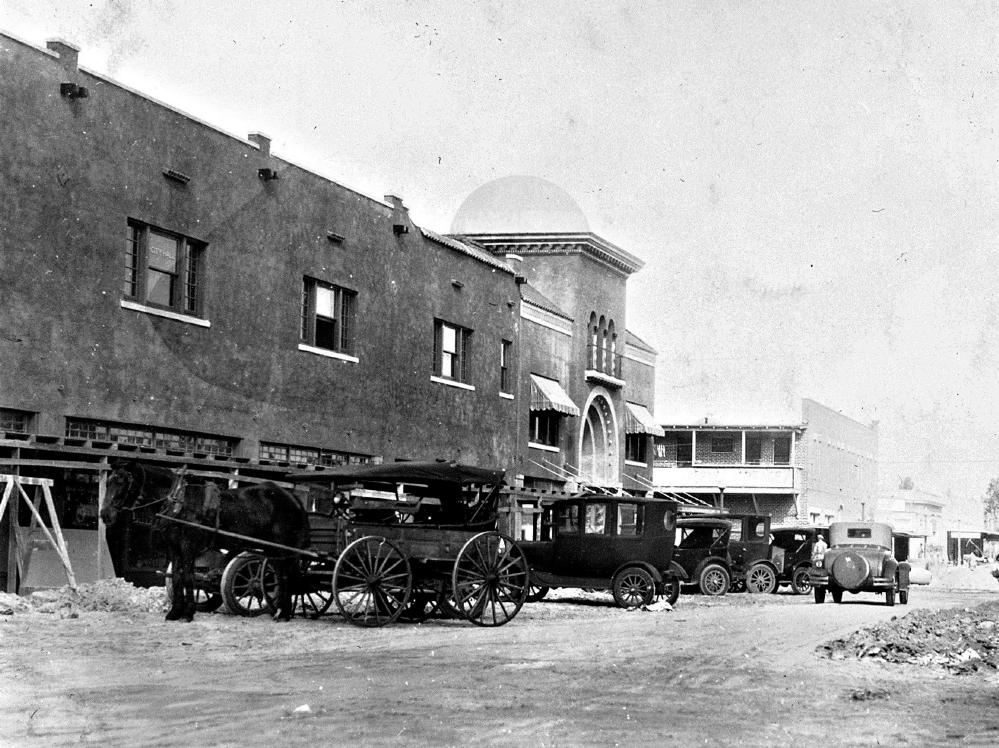
The plan was to build a new theatre on land purchased from Mr. Leeston-Smith at the corner of Boulevard and Nebraska Avenue. A frame building at the site, currently occupied by the Dixie Filling Station, was to be vacated and construction on the theatre would commence by October of 1925. Famed Sarasota architect Thomas Reed Martin had been consulted, and the building would be 50 by 95 feet, of modified Moorish type, of ornate design and finished with stucco. Arrangements with a leasing company, Calkins & Hudson of Brooksville – who already operated a chain of theatres – had been arranged. The theatre would have a capacity of 500 opera style seats, including a balcony of 150 seats. In addition to being a movie theatre, it would include a stage and drop-curtain for presentation of vaudeville acts and plays.
On October 23, 1925, the New Port Richey Press reported that material for the new palatial motion picture theatre had begun to arrive this week, and has been placed on the site ready for the beginning of construction. Ground for the new theatre was broken on Wednesday, November 4, 1925. The building contractor, L. C. Luppens, announced that the project would be “pushed as rapidly as the railroad can make delivery of materials”.
By June of 1926, the theatre was complete. And the New Port Richey Press reported, “New Port Richey’s beautiful new motion picture theatre has been named the ‘Thomas Meighan Theatre’ in tribute to the famous film star who has adopted New Port Richey as his favorite Florida city and who has been largely instrumental in interesting here some of the brightest stars of the screen and stage.”. The article went on to say, “It was hoped that Mr. Meighan would be on hand to crack a bottle of champagne over the corner-stone of the theatre. It was found to be impossible for the famous screen star to be present in person, but the next best happening is announced with the statement that the picture house’s first attraction will be Thomas Meighan in ‘The New Klondike,’ a picture of Florida during the boom.“.
The Meighan Theatre opened on July 1, 1926, with (as advertised) a showing of the movie The New Klondike, starring Meighan. According to the New Port Richey Press, congratulatory telegrams were read from the stage by State Senator Jesse Mitchell and Charles DeWoody. Telegrams were received from Meighan, Governor John W. Martin, Adolph Zukor, Ed Wynn, S. R. Kent, Gene Buck, David Warfield, Earl Benham, George R. Sims, and others. The newspaper reported that more than a hundred persons were unable to get seats at the opening, and that manager J. S. Jackson (owner of the previously mentioned Palms Theatre) announced that he had arranged to install a complete cooling system. Jackson also installed a pipe organ in the theatre.
On January 4, 1927, in the election for New Port Richey mayor and city council, residents voted to allow theaters to open on Sundays (120 votes for, 80 against). They also voted to allow baseball on Sundays, but voted not to allow dancing on Sundays. There apparently was an ongoing controversy about allowing the theatre to be open on Sundays. On January 11, 1929, the New Port Richey Press reported that J. S. Jackson, manager of the Meighan Theatre, said that it would be necessary to resume the showing of Sunday movies. He had agreed to stop showing movies on Sundays provided that attendance at the Tuesday and Wednesday shows was sufficient to offset the losses caused by giving up the Sunday and Monday pictures. He said, “The church people have had their chance. They failed to take advantage of it, so to protect ourselves we must return to Sunday, which was always our best day.”
Sometime in 1929 the Meighan Theatre closed. On Apr. 12, 1929, the New Port Richey Press reported that J. S. Jackson, “until last week manager of the Meighan Theatre here, has ‘gone back to his first love’ and is remodeling the old Palms theatre building again.” The Palms Theatre re-opened in early 1930. The Meighan Theatre re-opened in December 1929.
An advertisement for the Meighan Theatre on February 7, 1930, gave the admission price as 10 cents for children and 35 cents for adults. It showed movies scheduled seven days per week, each playing for two nights except for the Saturday feature.

On January 17, 1930, the New Port Richey Press reported that Thomas Meighan appeared in person at the theater between the two showings of his movie, The Racket. The article reported the largest attendance ever at the theater. “Promptly at the beginning of the second show, the expectancy of the packed auditorium was rewarded, for Thomas Meighan, in person, left his waiting limousine with Mrs. Meighan and another distinguished looking young lady and entered the theatre. Resounding cheers greeted the famous visitor following his introduction by Warren E. Burns, neighbor of the Meighans at Jasmin Point Estates, voicing appreciation of the entire city and surrounding country at being honored by the presence of the great actor.”
On March 7, 1930, the New Port Richey Press reported that sound movies would premiere at the Meighan Theatre on Sunday evening, March 9th. The article reported that the sound equipment was installed under the direction of E. B. Kinard of the Audiphone Corporation of America and included “both the disc and film type.” It was reported that Thomas Meighan was present to push the button that started the sound equipment.
On April 11, 1930, the New Port Richey Press reported, “There is a noticeable increase in patronage at the Meighan which is due to the perfection of the sound mechanism and a distinct understanding between Manager Poole and the film distributing agencies as to the quality of the releases assigned to the Meighan. The article also reported that the summer price schedule — 40 cents for adults and 15 cents for children — would go into effect next week.”. The newspaper also reported that the theater had recently offered a midnight show and would repeat this “innovation in the local amusement field” at “infrequent intervals.”
On May 2, 1930, the New Port Richey Press reported that the theater would temporarily abandon the showing of sound pictures and return to silent films for the summer because improvements in the sound needed to be made; prices would be reduced to 10 cents and 20 cents.
On November 28, 1930, the New Port Richey Press reported that the Meighan Theatre had re-opened and had been leased by John W. Freeman, who had formerly operated a theater in Daytona Beach. The article stated that the Meighan Theatre would be open on Fridays through Sundays until patronage warranted remaining open full time. The admission price was set at 30 cents for adults and 15 cents for children.

An ad for the Meighan Theatre in the New Port Richey Press on January 2, 1931, says “All Talking – Prices Always 30c and 15c.” It lists a Friday-Saturday double feature, a Sunday-Monday feature, and a Wednesday special. The Friday-Saturday presentation included “Graham McNamee Talking News.”
Sometime around 1934 the Meighan Theatre closed, a victim of the great depression.
In April of 1937, the theatre was purchased by Morris Legendre, head of a chain of southern theaters headquartered in Summerville, South Carolina. The April 26, 1937, edition of the St. Petersburg Evening Independent newspaper reported that the theater will open as a motion picture house on Nov. 1. According to another source, the theater was sold for $4,000. The name of the theater would be changed to the New Port Richey Theatre.
On January 28, 1938, the New Port Richey Press reported;
New Port Richey Theatre to Open Doors Tonight
The New Port Richey theatre, housed in the former Meighan theatre building, opens its doors to the public tonight, after a lapse of some four years.
The entire theatre has been newly decorated and renovated and made to conform to best acoustic possibilities for the showing of the best sound-with-picture entertainment that the operators can procure. The owners operate a string of theatres in Virginia, North and south Carolina and this is their first venture into Florida. They purchased the building here last spring and lately have made decided improvements to the property which cost in the days of the “boom” about $45,000.
Workmen have been busy all week making repairs and installing over 300 comfortable, leather upholstered seats. A special screen has been put into place and a modern projection machine placed in a fire proof booth. The building was originally built for theatre purposes only and has, in addition to the sloping main floor, a large balcony, a portion of which has been set aside for colored people. The entire seating capacity is around 500, according to Manager Sam Trincher, who has been in the city the past three weeks getting the place into shape for the gala opening tonight.
Rudy Snyder, a long-time local resident, recalled in a 1974 newspaper interview that black people who attended the theater in the early days bought their tickets at the box office and then went to the side of the building where they had to enter up a fire escape and sit in a segregated section of the balcony.
The purchasers of the theatre when it reopened in January of 1938 are believed to have been the Legendre brothers. The New Port Richey Theatre closed for the summer in 1938 and re-opened on Saturday night, October 15, 1938, under the management of Mr. and Mrs. H. P. Quigley. It operated for three days, after which time the people who had agreed to lease the theater left town because of a lack of finances. The New Port Richey Press reported, “The show, it is believed, if properly equipped and operated, would make money for someone, and would receive good support from people of this section.”. However, the business languished during this period.
On September 29, 1939, the New Port Richey Press reported;
Addison Miller Buys Local Theatre Block
St. Paul Man Adds to Holdings Here Through Recent Purchase – Includes All Equipment of Theatre
Announcement is made of the sale of the New Port Richey Theatre building to Addison Miller from the former owners, Legendre Brothers, of Summerville, S. C. This includes the theatre equipment, machines, seats, etc.
The price paid was not disclosed, but this is a valuable property, costing about $50,000 at time of erection, about 15 years ago, and the building is rated as being the best constructed in the city. It was formerly known as the Meighan theatre building, named for the famous movie actor, who died about four years ago and had a palatial home here, which was bought by Miller about a year ago.
It is planned to open the theatre here in November under lease, it is stated, to a thoroughly competent and responsible party. Legendre Brothers opened the show two years ago for a short time, but have done nothing with it since.
New Port Richey will support a good motion picture show, it is believed, and the plans now on foot are stated to be such that theatre goers here will get the best possible in this type of amusement.
As promised, Addison Miller contracted with Beach Amusements, Inc. of Tampa to operate the New Port Richey Theatre under lease. Improvements were made to the theatre equipment and premises, and they were ready to open for business on December 8, 1939. Under the new ownership, the name of the theatre was changed to “The Vogue Theatre”. The theatre managers were Mr. and Mrs. Lewis Cooper.
Once again, patrons flocked to the theatre to see the latest shows. According to news reports, The Vogue was open every night of the week except Thursday. By March of 1940, it was open seven days a week.
It should be noted that New Port Richey in the 1920s and 1930s was largely a resort town that saw many northern visitors during the winter months. Many of the rich and influential people who were responsible for the development of the town had winter homes in the city. But when the summer season came – in a time before air conditioning – many of the residents with money to spend on entertainment left for their northern homes. This is probably the largest reason why the local theatre suffered so many setbacks and changes in ownership. During the summer months, business would dry up … only to boom again – many times under new management – when tourist season arrived the next winter.
Nevertheless, The Vogue Theatre enjoyed much popular support during the summer of 1940 – closing for only a short time during August and September. The management took advantage of the slack time to install a new RCA sound system before re-opening again on September 29th. Now open four days a week, full time operation was expected again with the return of winter residents.
On July 12, 1940, the New Port Richey Press reported;
Vogue Theatre is taken over by Floyd Chain
Announcement is made this week of the purchase of the Vogue theatre business of this city by Floyd Theatres, a concern which operates a chain of nine theatres in Florida and nine in Georgia. The same concern operates nearby theatres of the Royal in Tarpon Springs and the Dade City theatre.
The former management played its last performance here Saturday night and the show was closed all of this week for repairs and changes, but will re-open on Sunday next, July 14, and will play each night with matinees Saturday and Sunday. New low prices 10c and 15c, which carries no government defense tax, will prevail.
Carl Floyd, head of the string of Floyd Theatres, was in the city this week closing the deal which netted his concern the local theatre, and is instituting some improvements for the show house, among which is the installation of a huge blower, suction type fan, which will add immeasurably to the comfort of theatre patrons. Other improvements will be made right along, so that by fall when the winter visitors arrive they will find a better theatre than ever before.
Jack Glavich has been named to manage the local theatre. He is well known to local folks as he has made his home here for some years, and has been employed in the Royal Theatre in Tarpons Springs.
Details about the ownership of the “Theatre Building” mentioned in the above article are unclear. After boom years during 1940 and 1941, business dropped off and the theatre no longer ran advertisements in the local paper. So it is a good guess that the theatre ceased doing business sometime in 1942. It does appear, however, that Addison Miller retained ownership, and his association with Floyd Theatres was a lease agreement – and not a sale.
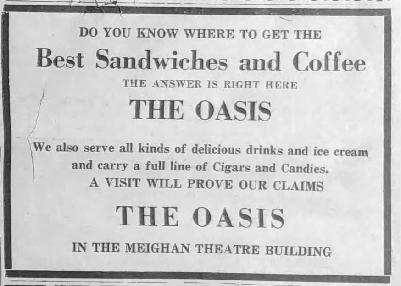
It is interesting to note that this building, used primarily as a movie theatre, also made space available to the north and south of the main entrance as a storefront or business office – including the rooms on each side upstairs. When it first opened as the Meighan Theatre in 1926, one of these spaces was leased by “The Oasis”, which was a coffee and sandwich shop. In 1927, the Oasis moved to the Seminole Building, and the Suwanee Ice Cream and Milk Depot began operating in the Theatre Building. The Woodcock Jewelry Company moved into the north office space in 1928. Other businesses in the Meighan Theatre Building were the Bentley Beauty Parlor (1929), Gulf Utilities Company (1929), The City Shoe Repair Shop (1936), naturopathic physician Dr. A. Krebs (1937), the New Port Richey Insurance Agency (Abt. 1940), Slack’s Sundries and Soda Fountain (1941), Vogue Cremerie ice cream shop (1945), A. F. Herman’s Barber Shop (1946), Mrs. H. C. Clark Dress Making Shop (upstairs over the barber shop – 1946), George Seigler’s Barber Shop (1948), The Flamingo Fountain Donut Shop (1958), and probably others.
In September 1944 Addison Miller died. His estate then sold the Theatre Building to Charles H. Richelieu in October of 1944. He was the owner of the Tarpon Theatre in Tarpon Springs. Richelieu re-opened the Vogue Theatre on Friday, January 26, 1945, showing Two Girls and a Sailor starring Van Johnson. The theater was again under the management of Lewis Cooper.
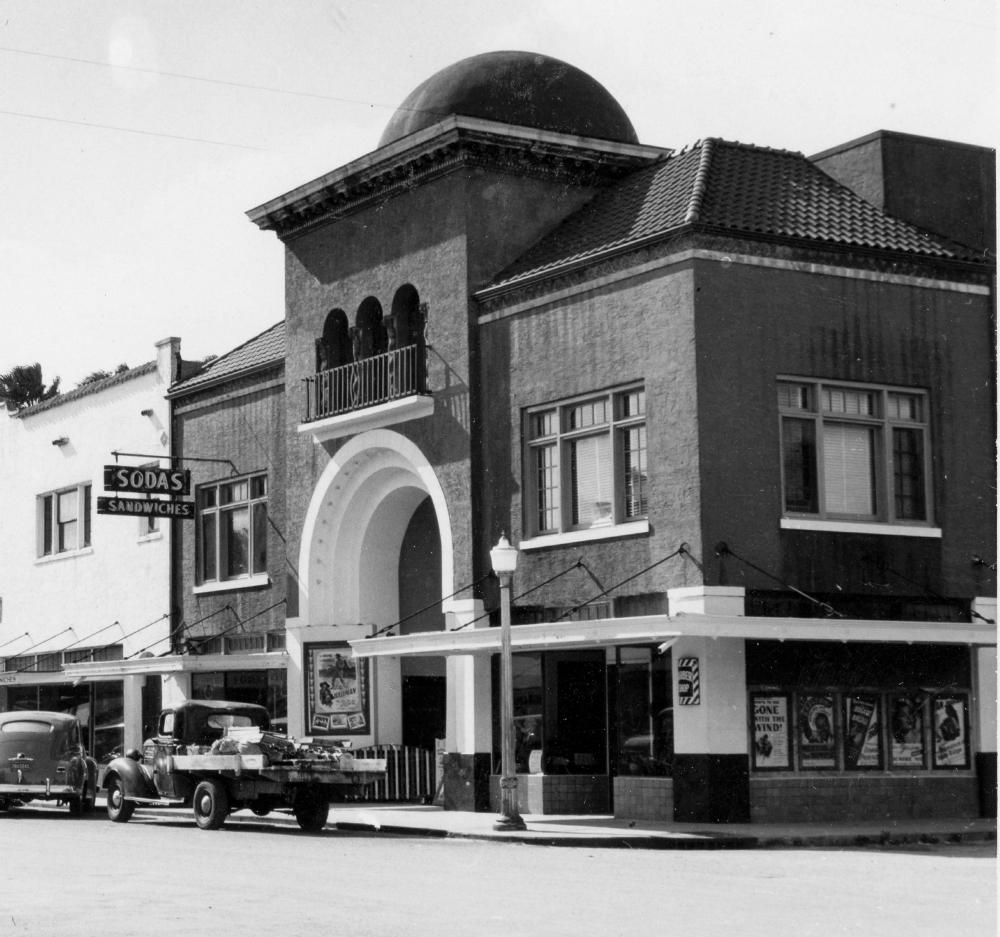
On November 14, 1947, the New Port Richey Press reported that the side walls of the Vogue Theatre were being re-covered to improve the acoustics and new balcony seats were being installed. The theater, still owned by Charles Richelieu, re-opened on November 29, 1947, under the management of Ralph N. Tippett. Then on October 14, 1949, the New Port Richey Press reported that R. F. Salzer would become the manager of the theater.
On. August 14, 1950, the New Port Richey Press reported that extensive improvements to the Vogue Theatre were underway including the extension of the back of the building, which would lengthen the theater by about 25 feet. The construction was designed to improve the picture quality and allow for more seats on the ground floor. Manager Ralph Tippett said the theater would not close for the summer, as had been reported, but might close for a brief period for certain changes to the building.
On December 29, 1950, the New Port Richey Press quoted Charles Richelieu as saying the remodeling was 90 per cent completed, the only thing remaining being the installation of luxurious carpets which had been ordered about four months ago but which had not yet arrived. The theater was extended about 30 feet, a new and larger floating screen was installed, and new seats were installed which were 22 inches wide, compared to 18 inches for the old seats. A new heating system was installed in the building, which was already completely air conditioned. On February 6, 1951, a celebration marking the remodeling was held. Before the movie began, Mayor Edwin C. Brookman made a short address and the Gulf High School band performed.
On May 18, 1951, the New Port Richey Press reported that Charles Richelieu sold the theater to H. C. Baker, lately of Tampa, who would move to New Port Richey.
Information for more recent years is currently lacking. However, it appears that in late 1961, the Vogue Theatre was still very much a successful business, and previous owner Charles Richelieu had regained ownership. An article in the Tampa Bay Times of February 27, 1961, reported;
Vogue Theatre Open Every Night
NEW PORT RICHEY – Beginning this week, the Vogue Theatre will be open every night with matinees on Saturday and Sunday starting at 2:30 p.m. Evening shows will start at 8 p.m.
According to C. H. Richelieu Sr., who took over operation of the theatre last week, new projection equipment soon will be purchased.
At some point, the name of the theater was changed from the Vogue to the Cinema.
In the early 1960s, the Church of Our Lady, Queen of Peace, which was severely overcrowded, rented the Cinema Theatre, and three Masses were celebrated there each Sunday. According to a history of the church, all told, some 1,500 parishioners were served in this piecemeal manner.
The Cinema, facing competition from a new rocking chair theater behind Southgate Shopping Center, ceased operations in 1969.
In May 1972 the Suncoast Young People’s Theater purchased the theater.
On August 24, 1972, the West Pasco Chronicle reported, “A few months ago the Suncoast Young People’s Theater purchased the old theater building, which has been variously known as the Thomas Meighan Theater, The Cinema, and The Vogue. Their purpose, in addition to finding a place to present their productions, was to obtain a building that might also serve as a cultural center for the area and in which other cultural events might take place.”
In 1972 the theater re-opened as a community theater featuring live productions under the name Richey Suncoast Theatre. The organization was formed at that time with a membership of 42 persons. The first production was Fiddler On the Roof in September 1972. More recently, the theatre has resumed the time-honored tradition of the Meighan Theatre by augmenting its theatrical season with movies and musical performances.
The Richey Suncoast Theatre currently occupies the entirety of the original Meighan Theatre Building. The office and business spaces on the south side of the main entrance are now occupied by a waiting room and the box office. The spaces to the north of the main entrance are occupied by a parlor area and snack bar.
The Richey Suncoast Theatre is at 6237 Grand Boulevard, New Port Richey, FL 34652.
Their website is https://www.richeysuncoasttheatre.com
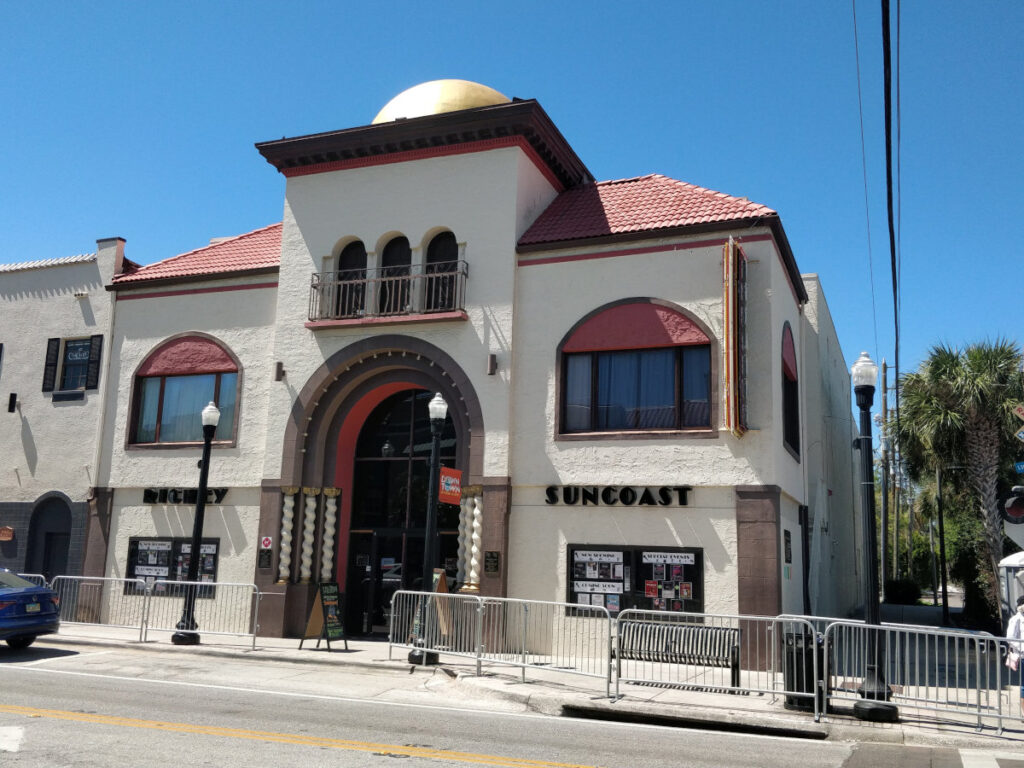
This article was added on March 25, 2024 by Paul Herman, digital media archivist, West Pasco Historical Society.
Some of the research for this page was done previously by Jeff Miller.
Page last edited by Paul Herman on March 26, 2024
